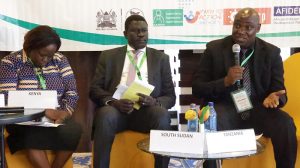Integrating population, health and environment policies and programmes can offer solutions for African governments who urgently need to invest more in healthcare provision in order to achieve global and national goals for reproductive health and rights, according to experts at the 13th Eastern Africa Reproductive Health Network (EARHN) coordination meeting in Nairobi, Kenya.

EARHN, a South-South advocacy network with membership of seven countries – Burundi, Ethiopia, Kenya, Rwanda, South Sudan, Tanzania, and Uganda – undertakes advocacy to improve policy, funding and visibility of reproductive health/family planning (RH/FP) outcomes in Eastern Africa.
The 13th coordination meeting held from May 30 to 31, 2023, and co-organised by the African Institute for Development Policy (AFIDEP) and Partners in Population and Development Africa Regional Office (PPD-ARO) focused on solutions to achieve universal health coverage (UHC) and the targets for reproductive health of the 2030 Agenda for Sustainable Development (SDGs). Target 3.7 of the SDGs aims to ensure universal access to sexual and reproductive healthcare services by 2030, including integrating RH into national strategies.
“Reproductive health outcomes remain poor in Eastern Africa. All the seven members countries of EARHN are far away from meeting the SDG target of reducing maternal deaths to 70 deaths in every 100,000 live births. Maternal deaths in the region range from 1,223 deaths in every 100,000 live births in South Sudan to 238 deaths in Tanzania in every 100,000 live births,” said Dr Rose Oronje, Head of AFIDEP’s Kenya Office, during a presentation at the event.
According to Dr Oronje, access to quality health services is still limited, due in part to the gravely inadequate investments in health by governments in the Eastern Africa region. None of the EARHN member countries has met the Abuja 2001 commitment of allocating at least 15% of their annual government budgets to health despite all countries being signatories to this declaration.
Some countries, such as Uganda, are spending as low as 3.1% of their budget on health in 2020. The picture becomes more depressing when one looks at the monies spent on reproductive health (RH). Majority of countries are spending dismally on RH, with Burundi leading the pack by spending 28% of its health expenditure on RH, while South Sudan trailing by spending a paltry 9% of its health expenditure on RH in 2020.
“This dismal expenditure on RH explains the high numbers of mothers who continue to die giving birth, and the high levels of teen pregnancy, among others,” she said.
Patrick Mugirwa, Programme Manager at PPD-ARO, also noted that Eastern Africa countries are not short of strong policies that advance access to quality reproductive health services and information for women, girls, adolescents, and young people.
“The problem, however, remains with implementing these policies,” he emphasised.
While governments in Africa have committed and signed on to UHC frameworks and other commitments, implementation of these commitments remains uneven.
“The current economic situation has eroded the little progress made in improving the healthcare sector,” Dr Rose Oronje added. “Strategies that will bolster domestic health financing must be put into action. Without more government funding for the health sector, universal health care will not be realised.”
Dr Oronje urged stakeholders to leverage the relationship between health, population and climate change to develop innovative strategies that will be fundamental in enabling the region to achieve UHC and sustainable development goals.
Clive Mutunga, Director of AFIDEP’s USAID-funded Building Capacity for Integrated Family Planning and Reproductive Health and Population, Environment and Development Action (BUILD) Project, further called for cross-sectoral approaches that foster the interconnectedness of health and FP/RH with other development sectors such as environment and climate change. Such platforms could be leveraged to increase the domestic resources for health.
Mr. Mutunga expanded that where environmental initiatives have been integrated with health programming, better health outcomes have been witnessed than before.
“The impact of integrating population, health and environment in Madagascar, Ethiopia, Rwanda and the Philippines has showed that using a peer engagement and stewardship model for conservation which also enables the spreading of messages about health and sexuality is more effective than providing information solely on reproductive health,” said Mutunga.
He added that in Rwanda, for instance, a project that included an integrated community health component for target coffee farmer groups found that the beneficiaries perceived the programme positively and that it successfully increased support for family planning.
According to the experts, the reasons behind inadequate domestic investments in health are complex and multi-faceted and are underpinned by many factors including lack of dialogue between the ministries of health and finance, environment and climate change, among others.
Nevertheless, as experts noted at the Nairobi meeting by the EARHN, the cases where integration is in practice show a clear pathway to achieving universal access to reproductive health services in the resource-constrained context Africa finds itself.
